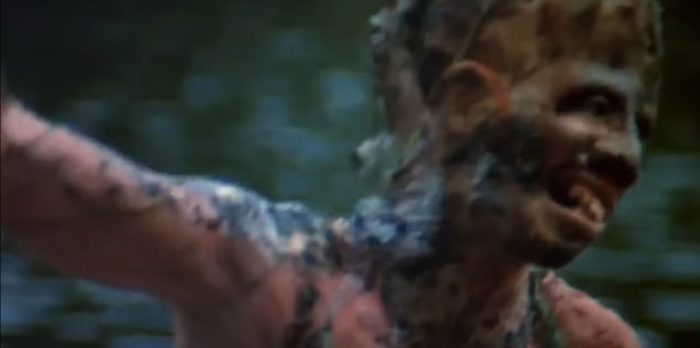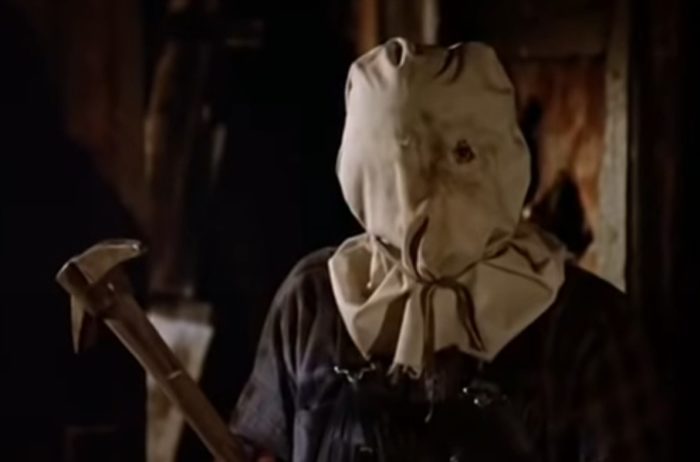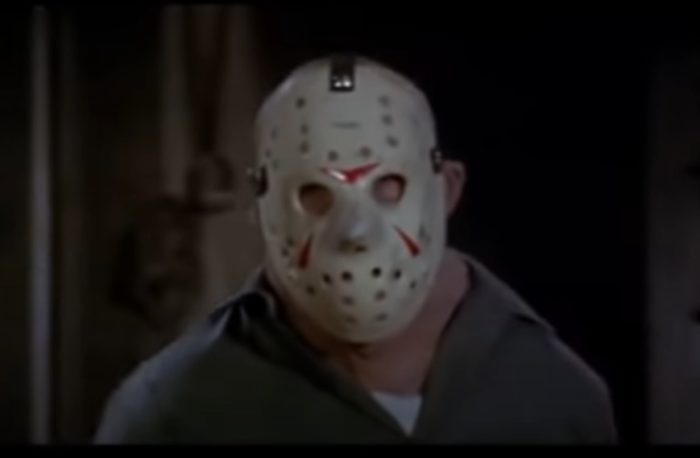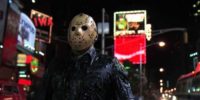Evolution isn’t the first thing that springs to mind when people mention Jason Voorhees. Usually, chatting about the terror of Crystal Lake conjures other notions: the infamous hockey mask, part of the character’s iconic imagery. However, evolution is an aspect of Jason and perhaps part of what helped him endure. Unlike other lethal legends, Jason didn’t arrive fully formed. In that respect, he stands apart from the slasher pack.
Take Freddy Krueger for example. Regardless of how sequels have added backstory or abilities, the appearance of Elm Street’s living nightmare never really changes. He’s been the blade-fingered bogeyman in fedora and sweater since the beginning. In many ways, that’s the goal whenever filmmakers design a killer. Furthermore, it’s best not to alter appearances since the killers are often the face of the franchise.
Michael Myers hasn’t changed since the start. Lumbering meatgrinder Victor Crowley owns a single incarnation. Pinhead, Leatherface, Candyman, Ghost Face—the list goes on. Every slaughter jockey arrives in a look that never changes. All of them except for Jason. That gives him something special. To a certain degree, he’s the first slasher to grow.

In the initial installment of Friday the 13th (1980), Jason barely even appears in the film. That’s no surprise, given he’s a red herring of sorts. Spoiler alert for a forty-year-old franchise, but he’s not the killer. His mother is the murderer. His main appearance, as portrayed by Ari Lehman, is as a deformed child in a scene that’s essentially a dream sequence.
Granted, the deformities exhibited in the segment have stuck with the character over time, but evolution is a gradual process. Jason’s disfigurements in that first feature seed the future that is to come. The pitiably grotesque child almost necessitates the bag worn by the fully grown Jason who arrives in Friday the 13th Part 2 (1981).
Masked killers are nothing new. Michael Myers, who predates the Friday franchise, certainly set the standard. Then, of course, real life offers the Phantom Killer, famous for the Texarkana Moonlight Murders, basis for the thriller The Town that Dreaded Sundown (1976). The mask dehumanizes the wearer, turning them into an anonymous source of death, one that has no face to offer any suggestion why they’ve come for blood—no emotion, identity, etc. Still, the so-called Baghead Jason is simply another step in the icon’s evolution. He’s donning the mantle of a masked murderer.

With the success of Part 2, Jason earned his position as the main evil in the emerging franchise. He survives into Friday the 13th Part III (1982) where we find him without the burlap sack. Jason makes his way sans mask until a certain point in the film. He then commits a kill and acquires, in a way by chance, what becomes his iconic visage. See, Jason didn’t seek out the hockey mask, nor does it have any special connection. He isn’t a crazed fan of Red Wings goalie Greg Stefan. Yet, the look came together in a way that’s lasted close to forty years.
It should be noted that producers didn’t initially intend for Jason to be the main antagonist. In many ways, he slashed his way into the hearts of horror fans. The original idea for sequels to Friday the 13th revolved around spiritual successors. Part 2 was even originally conceived as an anthology series. According to Peter Bracke’s Crystal Lake Memories, producer Phil Scuderi proposed the idea of bringing Jason back.
This partly explains why the character evolves the way he does. He was never conceived as a central element of the Friday the 13th franchise. Going back to movies like Nightmare on Elm Street or Halloween, their killers always sat at the center of the story. Jason sort of lumbered into the narrative core. As such, his character design changed over time.

Granted, a lot is owed more to chance than intention. During test shots, effects supervisor Martin Sadoff gave director Steve Miner a hockey mask to use on Jason. Miner liked the look so much it’s a blessing the script didn’t call for something specific. Again, there’s no real reason for Jason to settle on a goalie mask. In a way, perhaps we’re lucky filmmakers didn’t make that a recurring Friday the 13th gimmick with Jason Voorhees getting a new “face” at the start of each movie.
For whatever reason, though, that mask struck a chord. It cemented how the Crystal Lake killer appeared in every sequel afterward. I’d argue it’s the way the mask is vaguely human while remaining blank that gives it the haunting power it possesses. In addition, Jason, as a character, benefits from this chaotic development. Though he retains a certain aspect many slashers personify—an unstoppable force of nature—his appearance is cobbled together as the films progress, making him less elemental. Jason Voorhees doesn’t start out as an icon. He becomes the entity audiences recognize as the terror of Camp Blood.
A killer who changes can give a story room to maneuver in ways it might not have owned in the first place. Sure, having things set in stone makes it easier to plug and play. Yet, subsequent films risk falling prey to the formulaic dilemmas through which so much horror stumbles. Jason offers proof that a series can shapeshift even at its core without sacrificing what makes it glorious gore. Even as his appearance evolved, the essence of the narrative remained the same. Yet, the changes seem to subtly speak to facets of the character.
He grows from a simple sort of axe murderer to an unstoppable juggernaut who can return from the grave. That meant audiences got something new with each installment. Part of the fun in seeing a fresh Friday the 13th becomes seeing how Jason returns and in what form. It could even be argued that he comes back less human in each sequel.

These evolutions, from woodland serial killer to corpse juggernaut, also open various conversational avenues. Not everyone is going to wax philosophic about slasher flicks or speculate on the psychology of slashers. However, there are always a few folks, spurred by curiosity, who like to debate a character’s choices. Did Baghead Jason choose to wear a mask, or did his mother make him? Does he prefer to hide his deformities because he’s self-conscious? What does that say about his motivations as a killer? Is he monstrous or tragic?
Fan discussions deepen the films for franchise lovers, and when their hypotheses are shared, perhaps add something for other viewers as well. It’s a means of connecting to the films which isn’t as open in other series. Fans can speculate what motivated the choice of a burlap bag in a way they can’t with other killers. Going back to Freddy Krueger, Wes Craven has stated in multiple interviews and documentaries he made conscious choices for specific reasons. The claw, for instance, is supposed to harken back to primordial fears of animal attacks.
By contrast, Jason almost seems like a slasher assembled out of necessity. Rather than cut from whole cloth, his haphazard evolution is a crazy quilt of various elements. Watching the Friday the 13th franchise is like observing a tornado swirling to life then acquiring a terrible visage as it tears across the landscape. The way Jason comes together, seemingly at random, gives off the sense anything can become special. In other words, someone doesn’t have to hit the scene iconic. They can grow into the role.



